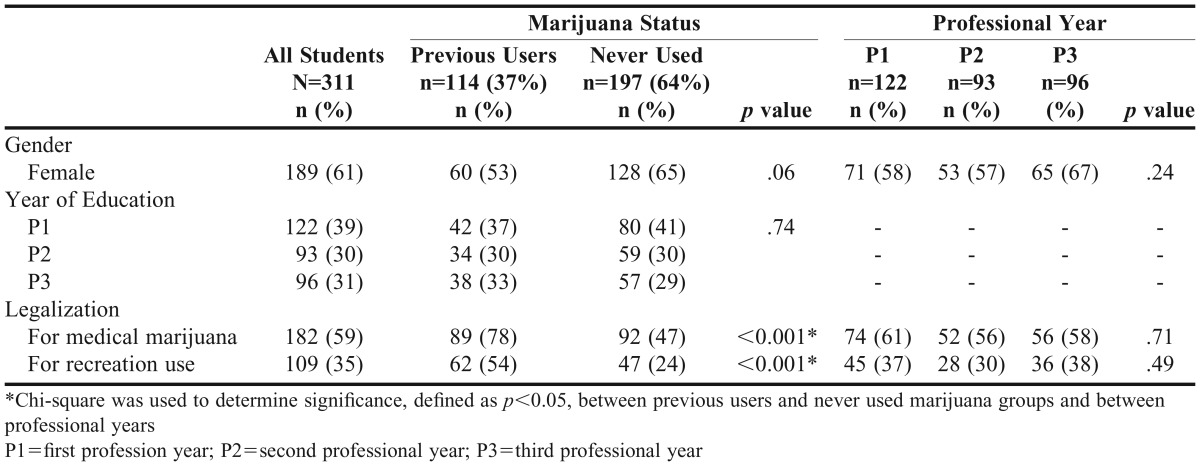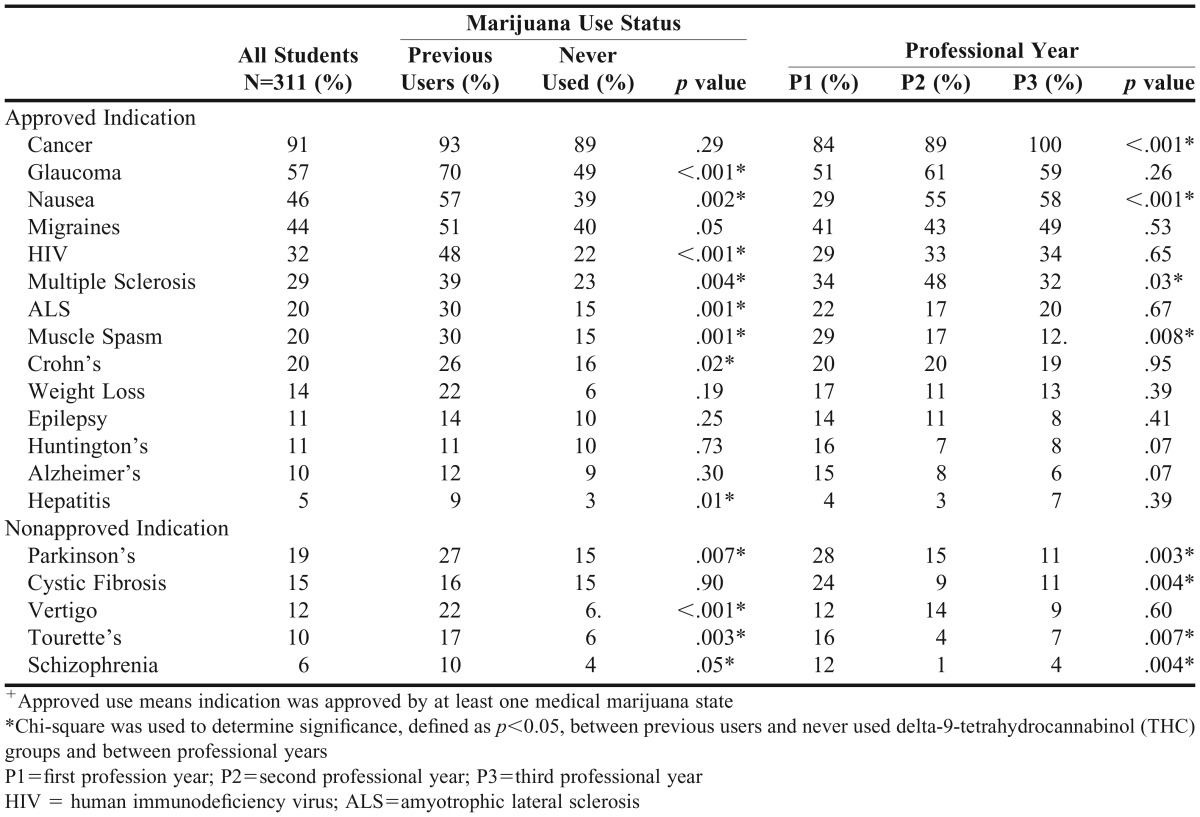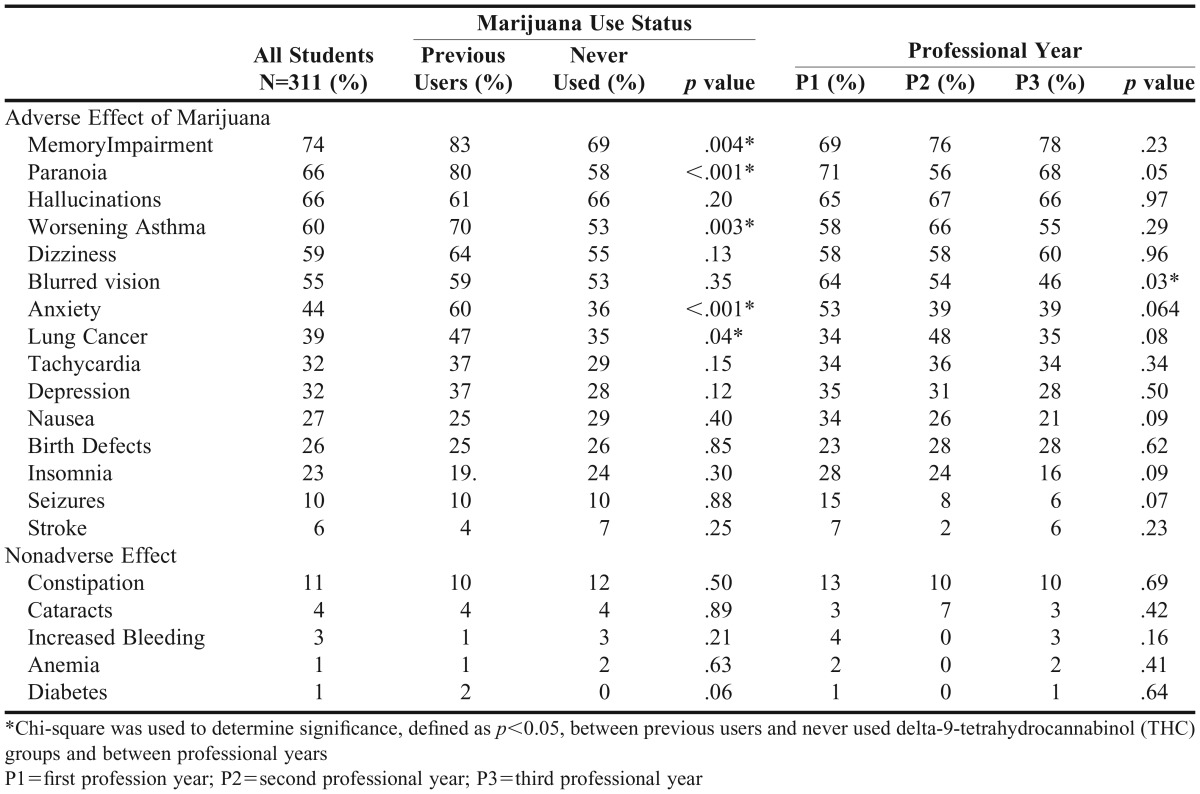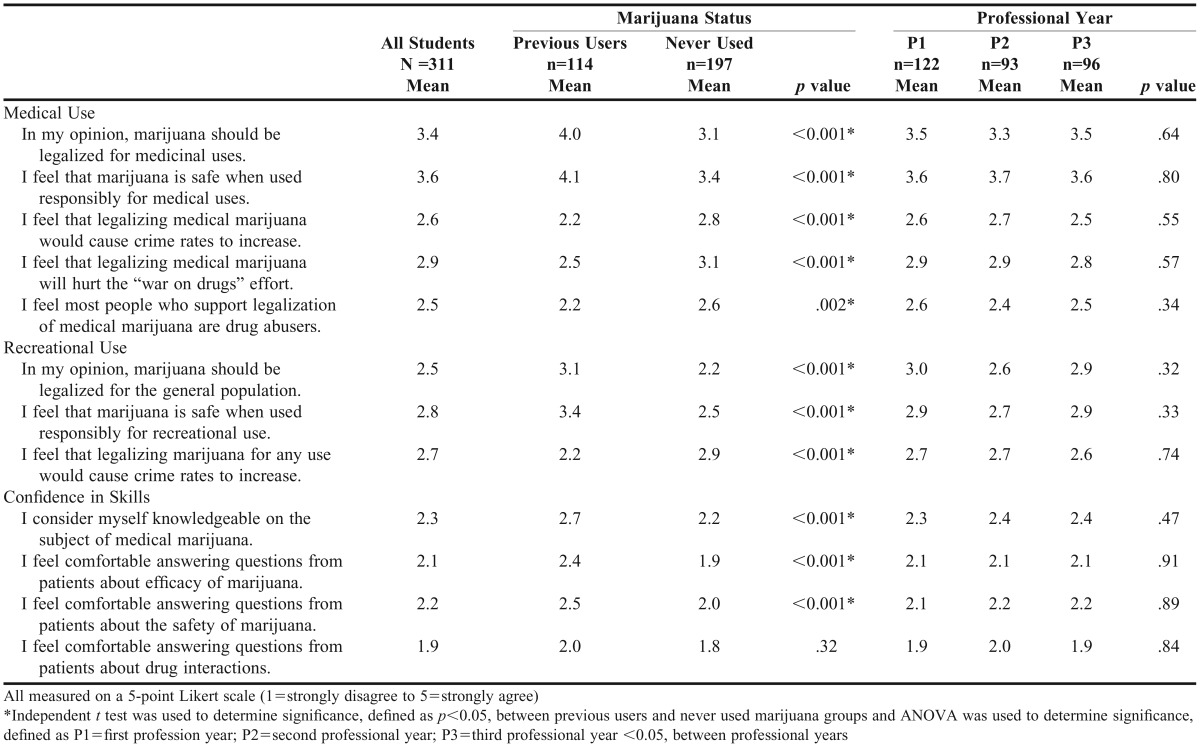Abstract
Objective. To determine pharmacy students’ knowledge of and attitudes toward medical marijuana and to determine if pharmacy students need additional education on the topic.
Methods. Pharmacy students were asked to complete a survey on medical marijuana that assessed their knowledge of, medical uses of, adverse effects with, and attitudes toward medical marijuana through 23 Likert-scale questions.
Results. Three hundred eleven students completed the survey. Fifty-eight percent of the students felt that medical marijuana should be legalized in all states. However, the majority of students did not feel comfortable answering consumers’ questions regarding efficacy, safety, or drug interactions related to the substance. Accurate responses for diseases or conditions for permitted medical marijuana use was low, with only cancer (91%) and glaucoma (57%) identified by more than half the students.
Conclusion. With an increasing number of states adopting medical marijuana use, pharmacy schools need to evaluate the adequacy of medical marijuana education in their curriculum.
Keywords: Medical marijuana, pharmacy students, knowledge, attitudes, pharmacy education
INTRODUCTION
Throughout history, marijuana has been used to treat a variety of diseases and illnesses. Use of marijuana for medicinal purposes has been referenced back to 2700 BC in Chinese medicine for treatment of gout, rheumatism, and absent-mindedness.1 The United States first recognized marijuana as a pharmaceutical agent in 1850, when it was listed in the US Pharmacopeia (USP). Its medicinal use continued throughout the United States until its criminalization in 1937. It was removed from the USP in 1942.
The term “medical marijuana” is generally associated with the use and consumption of the Cannabis plant, which is classified by the federal government under the Controlled Substance Act as a Schedule I substance, meaning it has a high potential for abuse, has no recognized medical uses, and is illegal to prescribe in the United States.2 Delta-9-tetrahydrocannabinol (THC) has been identified as the main chemical responsible for marijuana’s psychoactive effects. Two cannabinoid medications are approved by the Food and Drug Administration (FDA) that can be dispensed by pharmacists with a valid prescription: dronabinol (Schedule III) and nabilone (Schedule II).3,4 Dronabinol is the synthetic version of THC; nabilone is a synthetic cannabinoid chemically similar to THC. Both agents are approved for the treatment of chemotherapy-induced emesis. Dronabinol also is indicated for the treatment of anorexia in patients with Acquired Immune Deficiency Syndrome. For the purposes of this study, the term “medical marijuana” refers to the botanical Cannabis.
Over the past 20 years, there has been a cultural change in the United States regarding the perception and use of marijuana medicinally and recreationally. Research demonstrates some benefits for the use of medical marijuana for conditions such as severe nausea and vomiting, glaucoma, anorexia, chronic pain, and spasticity related to diseases such as multiple sclerosis.5-9 Smoking is the main form of marijuana consumption in research studies. However, subjects also ingest marijuana through vaporization, or orally (eg, desserts, candies, sodas). Results from some studies are difficult to extrapolate to the general population because of a lack of standardization of the active compounds in marijuana, and because of the difficulty in adequately blinding patients.
While the federal government has not relaxed legal restrictions on the use of marijuana, legalization and acceptance of medical marijuana by individual states has been increasing steadily over the past 20 years. Twenty-three states plus the District of Columbia approve the use of medical marijuana, and approximately 11 states have proposed legislation on legalization.10 Four states and the District of Columbia have approved the use of limited amounts of marijuana for recreational use. With conflicting state and federal laws, the role pharmacists and other health care professionals play with respect to medical marijuana can be controversial.
Health care organizations, such as the Institute of Medicine and the American Society of Health-System Pharmacists (ASHP), oppose the use of medical marijuana. However, both organizations advocate for more medical marijuana research.11,12 In 2011, ASHP issued a statement calling for more research on the clinical use and safety of medical marijuana and standardization of potency and formulations for medical marijuana research. Furthermore, they advocated continuing education for pharmacists on therapeutic and legal issues regarding medical marijuana use. Additionally, they were opposed to preparation and distribution of medical marijuana by licensed pharmacists, except for research.
With the growing trend in state legalization and increased patient use of medical marijuana, pharmacy students and pharmacists are likely to be consulted by patients and other health care professions on the safety, efficacy, and drug-drug or drug-disease interactions of medical marijuana. Furthermore, pharmacists are likely to be involved in policy developments and consulted on legal matters for use of medical marijuana in hospitals or other health care settings. In fact, some states are proposing that licensed pharmacists dispense medical marijuana.13 Yet, pharmacists may receive minimal to no education on medical marijuana in regards to safety, efficacy, and legal implications. Little information is available regarding pharmacists’ knowledge on medical marijuana, and controversy exists among pharmacists, legislators, and dispensary owners on who is best suited to provide patients with medical advice on the substance.14
A paucity of studies exist evaluating pharmacy students’ attitudes about medical marijuana legalization. In 1971, Burke and Marx conducted a study that assessed the attitudes of medical, law, and pharmacy students with respect to legal control of psychoactive substances (ie, alcohol, amphetamines, barbiturates, heroin, LSD, marijuana, morphine, and tranquilizers).15 They found that 70% of pharmacy students supported prohibition of marijuana compared with 29% among medical and law students. We found no studies that evaluated pharmacy students’ attitudes or knowledge of medical marijuana since its legalization in individual states. Thus, the goal of the study was to measure students’ knowledge of and attitude toward medical marijuana use to determine if additional education is needed.
METHODS
Pharmacy students from the first (P1), second (P2), and third years (P3) at a The University of Kansas were asked to complete an anonymous self-administered written survey regarding their knowledge and perceptions of medical marijuana, which is not legal in Kansas. All surveys were administered during the spring semester of 2011 during the last 20 minutes of a required course in the PharmD curriculum. Students were not required to complete the survey. The study was approved by the university’s Human Subjects Committee.
The survey was developed by 2 faculty members in the department of pharmacy practice who specialized in addiction and survey development. After initial development, the survey instrument was evaluated for face and content validity by 10 fourth-year pharmacy students and revised accordingly. The survey consisted of 3 separate domains. The first domain assessed knowledge of medicinal marijuana, including medical uses and adverse effects. In this domain, students were asked to circle potential medicinal uses for marijuana (14 had approved medical uses in various states and 5 were not approved for use in any states) and potential adverse effects of marijuana (15 adverse effects related to marijuana use and 5 adverse effects not associated with marijuana use).16 The approved uses for medical marijuana were chosen from a list of approved indications in 14 states where medical marijuana was legal at the time of survey development.16 All approved indications, except migraines, were approved in at least 2 or more states, with 9 of the indications approved by 90% of the states. To be included as an adverse effect, side effects were gathered from published literature and listed side effects of dronabinol and nabilone.3,4,11,17,18 The second domain, which measured student attitudes, contained a series of twenty-three 5-point Likert-scale questions (1=strongly disagree to 5=strongly agree). Students were asked about their attitudes regarding medical and recreational use of marijuana, and they were surveyed on their confidence levels in answering questions regarding efficacy, safety, and drug interactions of medical marijuana. The third domain included 6 closed-ended questions related to personal factors that could potentially affect attitudes and knowledge.
Responses were entered into an Excel worksheet, and accuracy was verified using a 10% random sample audit. We compared differences between professional years and between students who had previously used marijuana to students who had never used marijuana. Nominal variables were compared using chi-square. Scale data were compared using independent t tests between marijuana use status, and analysis of variance (ANOVA) was used to compare means between the 3 professional years. Statistical analysis was performed using SPSSv20 (SPSS, Inc., Chicago, IL), with a p value less than 0.05 defined as significant.
RESULTS
Three hundred eleven students completed the survey out of 360 (86% response rate; P1=122/150; P2=93/105; P3=96/105). The remaining students opted not to take the survey, turned it back in without any answers, or were excused from class the day the survey was administered. Demographics and marijuana-use status are reported in Table 1. Thirty-seven percent of students reported using marijuana at least once during their lifetime. Overall, 59% of the students felt that medical marijuana should be legalized in all states. Only 35% thought marijuana should be legalized for recreational use. Students who previously used marijuana were more in favor of legalization of medical (78%) or recreational (54%) use compared with students who had never used marijuana (p<0.001).
Table 1.
Demographics of Survey Participants

The ability of students to accurately identify indications for medical marijuana varied across diseases or illnesses (Table 2). Cancer (91%), glaucoma (57%), and nausea and vomiting (46%) were the most common conditions identified by students for medical marijuana use. Hepatitis C (5%) and Alzheimer’s disease (10%) were the least frequently identified uses. Students incorrectly identified 5 disease states, Parkinson’s (19%), cystic fibrosis (15%), vertigo (12%), Tourette’s syndrome (10%), and schizophrenia (6%). Students who previously used marijuana were more knowledgeable than students who reported never having used marijuana regarding 8 approved indications (glaucoma, nausea, human immunodeficiency virus, multiple sclerosis, amyotrophic lateral sclerosis, muscle spasms, Crohn’s disease and hepatitis).16 However, they also reported more unapproved indications than those who had never used marijuana.
Table 2.
Students Identifying an Approved+ or Nonapproved Indication for Medical Marijuana

An increase in knowledge occurred from the first-year to third-year students regarding the use of medical marijuana for cancer (P1=84%, P2=89%, P3=100%; p<0.001) and nausea (P1=29%, P2=55%, P3=58%; p<0.001). However, more first-year students correctly answered muscle spasms as approved indications for medical marijuana compared with the other professional years (p<0.05).
With respect to side effects, most students identified impaired memory (74%), hallucinations (66%), and paranoia (66%) as potential side effects of marijuana (Table 3). Again, students who previously used marijuana more often identified anxiety, lung cancer, memory impairment, paranoia, and worsening asthma as side effects of marijuana compared with students who reported never having used marijuana (p<0.05). There were no differences between professional years with respect to adverse effects, except more first-year students correctly identified blurred vision as a side effect than second-year or third-year students.
Table 3.
Percentage of Pharmacy Students Identifying an Adverse Effect of Medical Marijuana

The second domain of the survey measured students’ attitudes and opinions (Table 4) about the safety and legality of both medical and recreational marijuana use and their confidence and comfort level in conveying marijuana information to consumers. Students did not feel comfortable answering consumer questions regarding efficacy, safety, or potential drug interactions with medical marijuana (mean 2.1, 2.2, and 1.9, respectively). However, students who had previously used marijuana reported feeling slightly more confident answering questions about medical marijuana than students who had never used marijuana. There were no statistical differences with respect to students’ attitudes among professional years.
Table 4.
Pharmacy Students Opinions Towards Marijuana

In the third domain of the survey, students were asked if they had received any instruction in the school of pharmacy on medical marijuana and whether they felt that faculty members should include marijuana education in the curriculum. Thirteen percent of students reported receiving some instruction on medical marijuana in the curriculum, primarily in medicinal chemistry, and briefly during the oncology section of pharmacotherapy. Nonetheless, 90% of students indicated that they felt more instruction on medical marijuana should be incorporated into the curriculum.
DISCUSSION
A majority of pharmacy students in this study lacked accurate knowledge about the approved therapeutic indications and adverse effects of medical marijuana. The only approved medical indications correctly identified by more than 50% of pharmacy students were for the treatment of cancer and glaucoma (91% and 57%, respectively). In contrast, notably more students correctly identified common adverse effects of marijuana, particularly those affecting the central nervous system. Perhaps not surprisingly, previous users of marijuana were more knowledgeable than students who reported never using marijuana regarding indications and adverse effects. No consistent trends were found between year of study and knowledge.
Despite an apparent lack of accurate knowledge about marijuana, the majority of pharmacy students favored legalizing marijuana for medical purposes, but did not support its legalization for recreational use. These results contrast markedly from student attitudes described by Burke and Marx in a study conducted more than 40 years ago.15 In that study, only a small percent of pharmacy students supported the use of medical or recreational use of marijuana (16% and 14%, respectively) compared with 58% and 35% in our study. Changes in state legalization, cultural acceptance, personal use, news and social media coverage, and decreased perception of risk have undoubtedly combined to shift opinions over the past 4 decades.
More recent studies have examined temporal changes in attitudes and perceived risks of marijuana over time.19-21 Schuermeyer et al used data from the National Survey on Drug Use and Health (2003-2011) to assess trends in marijuana attitudes and use in Colorado (approved medical marijuana state) and compared them to states without medical marijuana laws.20 The authors correlated a downward decline since 2009 in Coloradans’ attitudes toward perceived risk of using marijuana and concluded that commercialization of marijuana in Colorado was associated with a decrease perception of risk.
Attitudes of pharmacy students toward the use of medical marijuana also contrasted with attitudes expressed by physicians. In a recent study administered to family physicians in Colorado, 46% felt physicians should never recommend marijuana as a medical treatment in contrast to 19% who felt physicians should recommend medical marijuana.22 Additionally, more than 60% of physicians surveyed agreed that marijuana possesses significant physical and mental health risks. An earlier study by Charuvastra et al looked at physicians from multiple specialties and found 36% of physicians were in favor of legalization of medical marijuana.23 Similarly, Schwartz et al’s survey of oncologists found 30% of respondents were in favor of legalization of medical marijuana.24 In comparison to our study, physicians were less in favor of medical marijuana than pharmacy students. The notable difference in attitudes between physicians and pharmacy students may be partly a result of greater physician knowledge informed by years of clinical experience, but also may reflect added physician responsibility of prescribing marijuana and monitoring patients for possible adverse effects.
Students in our study indicated they had received little to no education regarding the use of medical marijuana in the pharmacy curriculum. However, 90% indicated they should receive some formal education. The low confidence and comfort levels pharmacy students expressed about their ability to answer patients’ marijuana questions may reflect this lack of formal education. Likewise, physicians in the Colorado survey indicated a strong desire for more formal education regarding medical marijuana.22 Most physicians reported learning about medical marijuana from the news, other physicians, and/or patients rather than from a formal educational setting, such as continuing medical education. Our study did not ask pharmacy students how they learned about medical marijuana. Pharmacy school curricular standards as published in the new Accreditation Council for Pharmacy Education (ACPE) Standards and Guidelines do not specifically mention the topic of medical marijuana, although it may be assumed to be covered under the topic of drug abuse.25
A major limitation of our study was that it was conducted at only one institution in a state where use of medical marijuana is not legal. Schools of pharmacy in states where medical marijuana is approved may cover this topic in more detail and, thus, potentially produce different results. Because of the sensitive nature of asking pharmacy students to self-report an illegal behavior, classifying students as previous users and those who had never used could be flawed. Only 36% of students indicated past use of marijuana. That is significantly lower than McAuliffe et al’s survey, conducted in 1987, that showed 52% of pharmacy students had used marijuana.26 Baldwin et al found a difference in geographical areas in terms of pharmacy students past use of marijuana, with a higher percentage of students in a southwestern state having used marijuana compared with students in the Midwest.27
Student confusion about terminology used in our survey may be another study limitation. We included the treatment of Huntington’s disease as an approved indication for medical marijuana based on treatment of spasticity-related disorders. Students not familiar with the symptoms of Huntington’s disease likely would not have selected it as an approved indication.
As the legal status of marijuana use changes, and clinical research proliferates, the list of approved and nonapproved uses for medical marijuana will change. For example, Lotan et al reported potential benefits of medical marijuana for the treatment of Parkinson’s disease, although they concluded that more research needed to be conducted.28 Consequently, future versions of our survey would require the list of approved and nonapproved indications to be revised accordingly. This survey did not query pharmacy students on their knowledge of legal risks and their views about recommending the use of marijuana to consumers for medical purposes. A future survey should be developed to evaluate student and pharmacist knowledge of legal implications of recommending marijuana to patients.
CONCLUSION
Pharmacy students have a knowledge gap about medical uses and adverse effects of medical marijuana, which may reflect a lack of formal education in their pharmacy curriculum. If the use of marijuana shifts from an illegal substance to a prescribed medicinal agent, pharmacy students and other health care professionals will need education and training to competently address its safe and effective use. Pharmacy student interns will need to learn to ask about medical marijuana on medication reconciliations, learn how to address the issue of patient use while in a hospital setting, advise patients on the risks and accidental exposure of marijuana in the pediatric population, and inform patients about health risks and drug interactions associated with the substance. Pharmacy students also need to understand the lack of medical marijuana standardization with respect to potency and methods of consumption, which make it difficult to give advice on dosage and efficacy. Most importantly, pharmacy students need to understand state laws with respect to recommending the use of medical marijuana for any condition. Pharmacy schools need to evaluate the adequacy of medical marijuana education in their courses and consider revising curriculum accordingly.
REFERENCES
- 1.Li HL. An archaeological and historical account of cannabis in China. Econ Bot. 1974;28(4):437–447. [Google Scholar]
- 2. 21 USC 812 et seq. http://www.fda.gov/regulatoryinformation/legislation/ucm148726.htm. Accessed May 16, 2014.
- 3.Marinol (dronabinol) [package insert] Chicago, IL: AbbVie Inc; 2013. [Google Scholar]
- 4.Cesamet (nabilone) [package insert] Somerset, NJ: Meda Pharmaceuticals Inc; 2011. [Google Scholar]
- 5.Aggarwal SK, Carter GT, Sullivan MD, ZumBrunnen C, Morrill R, Mayer JD. Medicinal use of cannabis in the United States: historical perspectives, current trends, and future directions. J Opioid Manag. 2009;5(3):153–168. doi: 10.5055/jom.2009.0016. [DOI] [PubMed] [Google Scholar]
- 6.Ben Amar M. Cannabinoids in medicine: a review of their therapeutic potential. J Ethnopharmacol. 2006;105(1-2):1–25. doi: 10.1016/j.jep.2006.02.001. [DOI] [PubMed] [Google Scholar]
- 7.Haney M, Gunderson EW, Rabkin J, et al. Dronabinol and marijuana in HIV-positive marijuana smokers. Caloric intake, mood, and sleep. J Acquir Immune Defic Syndr. 2007;45(5):545–554. doi: 10.1097/QAI.0b013e31811ed205. [DOI] [PubMed] [Google Scholar]
- 8.Wilsey B, Marcotte T, Tsodikov A, et al. A randomized, placebo-controlled, crossover trial of cannabis cigarettes in neuropathic pain. J Pain. 2008;9(6):506–521. doi: 10.1016/j.jpain.2007.12.010. [DOI] [PMC free article] [PubMed] [Google Scholar]
- 9.Zhan GL, Camras CB, Palmberg PF, Toris CB. Effects of marijuana on aqueous humor dynamics in a glaucoma patient. J Glaucoma. 2005;14(2):175–177. doi: 10.1097/01.ijg.0000151882.07232.1d. [DOI] [PubMed] [Google Scholar]
- 10.23 legal medical marijuana states and D.C.: laws, fees, and possession limits. 2014. http://medicalmarijuana.procon.org/view.resource.php?resourceID=000881. Accessed December 12, 2014.
- 11.Joy J, Watson S, Benson J, editors. Washington, D.C.: National Academy Press; 1999. Marijuana and medicine: assessing the science base. [PubMed] [Google Scholar]
- 12.American Society of Health-System Pharmacists. Medical Marijuana(1101) http://www.ashp.org/DocLibrary/BestPractices/GovPositions.aspx . Accessed May 16, 2014.
- 13.Marcoux RM, Larrat EP, Vogenberg FR. Medical marijuana and related legal aspects. PT. 2013;38(10):612–619. [PMC free article] [PubMed] [Google Scholar]
- 14.McCoppin R. Pharmacists push for role in marijuana sales. January 22, 2014. Chicago Tribune. http://articles.chicagotribune.com/2014-01-22/health/ct-medical-marijuana-pharmacist-met-20140115_1_medical-marijuana-medicinal-marijuana-marijuana-dispensary. Accessed May 16, 2014.
- 15.Burke WM, Marx MB. Attitudes of professional students toward legal control of psychoactive substances. HSMHA Health Rep. 1971;86(8):725–732. [PMC free article] [PubMed] [Google Scholar]
- 16.Hoffmann DE, Weber E. Medical marijuana and the law. N Engl J Med. 2010;362(16):1453–1457. doi: 10.1056/NEJMp1000695. [DOI] [PubMed] [Google Scholar]
- 17.Hall W. The adverse health effects of cannabis use: what are they, and what are their implications for policy? Int J Drug Policy. 2009;20(6):458–466. doi: 10.1016/j.drugpo.2009.02.013. [DOI] [PubMed] [Google Scholar]
- 18.Seamon MJ, Fass JA, Maniscalco-Feichtl M, Abu-Shraie NA. Medical marijuana and the developing role of the pharmacist. Am J Health Syst Pharm. 2007;64(10):1037–1044. doi: 10.2146/ajhp060471. [DOI] [PubMed] [Google Scholar]
- 19.Cerda M, Wall M, Keyes KM, Galea S, Hasin D. Medical marijuana laws in 50 states: investigating the relationship between state legalization of medical marijuana and marijuana use, abuse and dependence. Drug Alcohol Depend. 2012;120(1-3):22–27. doi: 10.1016/j.drugalcdep.2011.06.011. [DOI] [PMC free article] [PubMed] [Google Scholar]
- 20.Schuermeyer J, Salomonsen-Sautel S, Price RK, et al. Temporal trends in marijuana attitudes, availability and use in Colorado compared to non-medical marijuana states: 2003-11. Drug Alcohol Depend. 2014;140:145–155. doi: 10.1016/j.drugalcdep.2014.04.016. [DOI] [PMC free article] [PubMed] [Google Scholar]
- 21.Wall MM, Poh E, Cerda M, Keyes KM, Galea S, Hasin DS. Adolescent marijuana use from 2002 to 2008: higher in states with medical marijuana laws, cause still unclear. Ann Epidemiol. 2011;21(9):714–716. doi: 10.1016/j.annepidem.2011.06.001. [DOI] [PMC free article] [PubMed] [Google Scholar]
- 22.Kondrad E, Reid A. Colorado family physicians’ attitudes toward medical marijuana. J Am Board Fam Med. 2013;26(1):52–60. doi: 10.3122/jabfm.2013.01.120089. [DOI] [PubMed] [Google Scholar]
- 23.Charuvastra A, Friedmann PD, Stein MD. Physician attitudes regarding the prescription of medical marijuana. J Addict Dis. 2005;24(3):87–93. doi: 10.1300/J069v24n03_07. [DOI] [PubMed] [Google Scholar]
- 24.Schwartz RH, Voth EA, Sheridan MJ. Marijuana to prevent nausea and vomiting in cancer patients: a survey of clinical oncologists. South Med J. 1997;90(2):167–172. doi: 10.1097/00007611-199702000-00001. [DOI] [PubMed] [Google Scholar]
- 25.Accreditation Standards and Key Elements for the Professional Program in Pharmacy Leading to the Doctor of Pharmacy Degree (Standards 2016), Accreditation Council for Pharmacy Education. https://www.acpe-accredit.org/standards/default.asp Accessed August 17, 2015.
- 26.McAuliffe WE, Santangelo SL, Gingras J, Rohman M, Sobol A, Magnuson E. Use and abuse of controlled substances by pharmacists and pharmacy students. Am J Hosp Pharm. 1987;44(2):311–317. [PubMed] [Google Scholar]
- 27.Baldwin JN, Scott DM, DeSimone EM, 2nd, Forrester JH, Fankhauser MP. Substance use attitudes and behaviors at three pharmacy colleges. Subst Abus. 2011;32(1):27–35. doi: 10.1080/08897077.2011.540470. [DOI] [PubMed] [Google Scholar]
- 28.Lotan I, Treves TA, Roditi Y, Djaldetti R. Cannabis (medical marijuana) treatment for motor and non-motor symptoms of Parkinson disease: an open-label observational study. Clin Neuropharmacol. 2014;37(2):41–44. doi: 10.1097/WNF.0000000000000016. [DOI] [PubMed] [Google Scholar]


